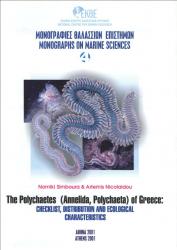Title:
The polychaetes (Annelida, Polychaeta ) of Greece: Checκlist, distribution, and ecological characteristics
Abstract:
Monograph deals with the class of the Polychaetous Annelids (Annelida, Polychaeta) in the Greek seas (Greece, Eastern Mediterranean) providing a checklist of the polychaete species recorded in the area and focusing on their distribution and ecology.
An introductory chapter outlines the basic external morphological characters of this group, the polychaete life habits and their significance in benthic ecosystems including also a short review of the history of polychaete research in the
Mediterranean and a brief biogeographical analysis of the Greek polychaete fauna. Poiychaetes are the most frequent and abundant marine imetazoans in benthic ecosystems with soft sediments.
In undisturbed benthic ecosystems studied around Greece, poiychaetes have been found to account for 50-83% in terms of specimens and 40-67% in terms of species. In disturbed to polluted areas poiychaetes increase at the expense of other benthic
groups and may totally monopolise the fauna. The first documents available on benthic Polychaeta recorded from Greece date back to 1891. Since then a great ammount of research has been carried out, some of thenn focusing on Polychaete taxonomy. A
Monograph deals with the class of the Polychaetous Annelids (Annelida, Polychaeta) in the Greek seas (Greece, Eastern Mediterranean) providing a checklist of the polychaete species recorded in the area and focusing on their distribution and ecology. An introductory chapter outlines the basic external morphological characters of this group, the polychaete life habits and their significance in benthic ecosystems including also a short review of the history of polychaete research in the Mediterranean and a brief biogeographical analysis of the Greek polychaete fauna. Poiychaetes are the most frequent and abundant marine imetazoans in benthic ecosystems with soft sediments.
In undisturbed benthic ecosystems studied around Greece, poiychaetes have been found to account for 50-83% in terms of specimens and 40-67% in terms of species. In disturbed to polluted areas poiychaetes increase at the expense of other benthic groups and may totally monopolise the fauna. The first documents available on benthic Polychaeta recorded from Greece date back to 1891. Since then a great ammount of research has been carried out, some of thenn focusing on Polychaete taxonomy. A biogeographical analysis of 364 species of Polychaeta recorded from Greece with known biogeographical origin shows dominance (50%) of the Atlantic-Mediterranean species, followed by the cosmopolitan (15%), the disjunct distribution species (14%), the Mediterranean endemics (10%), the subtropical (7%) and last the Indopacific species (4%).
A total of 753 species of poiychaetes were recorded in the Greek seas from 1891 up to the year 2000. The inventory of these species is given including also their analytical geographical distribution around Greece and the corresponding sources of reference in a coded format. Among the 753 species reported in Greek waters, 270 are considered to present significant ecological characteristics and are listed in a comprehensive table including the ecological information and the sources of reference. The table refers to any ecological characteristic attributed to these species concerning environmental factors such as depth, type of substrate, light conditions, salinity, hydrodynamism etc, or any association of the species to a type of habitat or biocoenosis. Special reference is also made in the case of several species which are tolerant or resistant to pollution. Such species are regarded as bioindicators and are of special value in pollution assessments and ecological quality classification.











